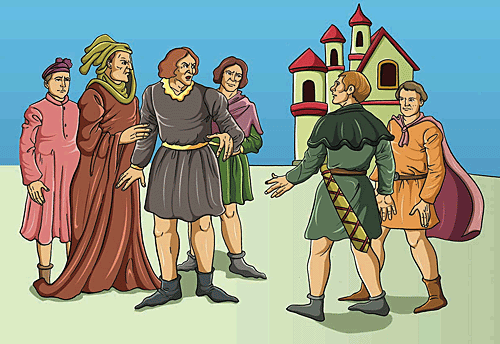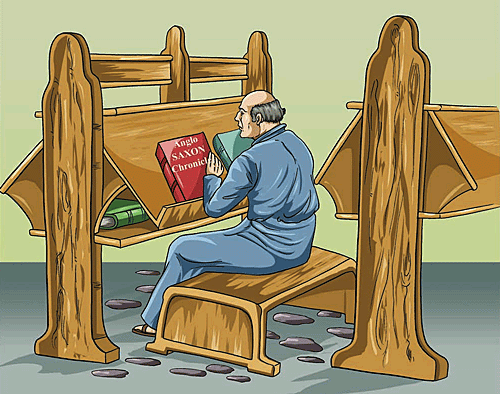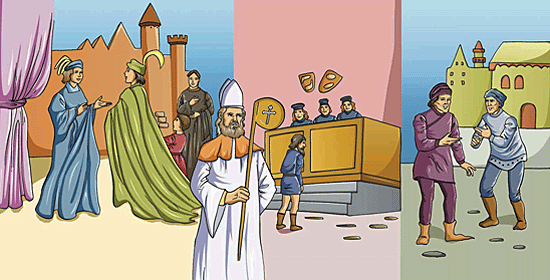English and Its Historical Development, Part 19
(Middle English period)
A.D. 1150-1500 is considered to be the Middle English Period

The Norman on the left is thinking: "Vous êtes des barbares" ("You barbarians").
Unlike the Vikings, the Normans did not assimilate with the local population and had nothing but scorn for local customs and language. All governing classes spoke French.
The Norman Conquest and Middle English
William the Conqueror, the Duke of Normandy, invaded and conquered England and the Anglo-Saxons in 1066 A.D. The new overlords spoke a dialect of Old French known as Anglo-Norman.
The Normans were also of Germanic stock; "Norman" comes from "Norseman", and Anglo-Norman was a French dialect that had considerable Germanic influences in addition to the basic Latin roots.
Prior to the Norman Conquest, Latin had been only a minor influence on the English language, mainly through vestiges of the Roman occupation and from the conversion of Britain to Christianity in the seventh century (ecclesiastical terms such as priest, vicar, and mass came into the language this way), but now there was a wholesale infusion of Romance (Anglo-Norman) words.
The influence of the Normans can be illustrated by looking at two words, "beef" and "cow". Beef, commonly eaten by the aristocracy, derives from the Anglo-Norman, while the Anglo-Saxon commoners, who tended the cattle, retained the Germanic cow.
Many legal terms, such as indict, jury, and verdict have Anglo-Norman roots because the Normans ran the courts.
This split, where words commonly used by the aristocracy have Romantic roots and words frequently used by the Anglo-Saxon commoners have Germanic roots, can be seen in many instances.
Sometimes French words replaced Old English words; "crime" replaced firen and "uncle" replaced eam.
In other times, French and Old English components combined to form a new word; such as, the French "gentle" and the Germanic "man" formed gentleman.
It is useful to compare various versions of a familiar text to see the differences between Old, Middle, and Modern English. Take for instance this Old English (c.1000) sample:
| French | English |
| close | shut |
| reply | answer |
| odour | smell |
| annual | yearly |
| demand | ask |
| chamber | room |
| desire | wish |
| power | might |
| ire | wrath / anger |
Because the English underclass cooked for the Norman upper class, the words for most domestic animals are English (ox, cow, calf, sheep, swine, deer) while the words for the meats derived from them are French (beef, veal, mutton, pork, bacon, venison).
The Germanic form of plurals (house, housen; shoe, shoen) was eventually displaced by the French method of making plurals: adding an "s" (house, houses; shoe, shoes). Only a few words have retained their Germanic plurals: men, oxen, feet, teeth, children.
French also affected spelling so that the cw sound became qu; for example, cween became "queen".
Modern English began around the 16th Century and, like all languages, is still changing. One change occurred when the "th" of some verb forms became "s" (loveth, loves; hath, has). Auxillary verbs also changed (he is risen, he has risen).

English was banned from all polite and official usage, and practically ceased to be a written language. Only the monks at Peterborough continued to record the events of English history in the Anglo-Saxon Chronicle.
The chronicle is considered to be the first history in the English language to use the dating system Anno Domini, "In the Year of our Lord"; that is, in the year after the Nativity (the birth of Jesus Christ); or A.D. This system of dating with A.D. is credited to the monk Dionysius Exiguus, who lived in the first half of the 6th century.
The Anglo-Saxon Chronicle was probably begun in the reign of Alfred the Great (871-899). It included events from the time of Julius Caesar to 1145 A.D. and it is the basic source of information for the history of Anglo-Saxon England.
1200-1500: The Re-establishment of English took place

In the early 1200's, England had a trilingual composition. French was the literary and courtly language; Latin was the language of the church and legal documents; English was the language of communication among the common people.
Proceed to Part 20, English re-established in Britain.
INDEX or Table of Contents, English and its historical development.
References: sources of information.
